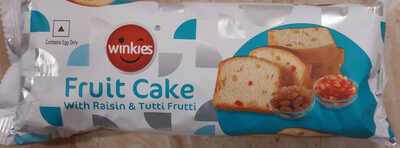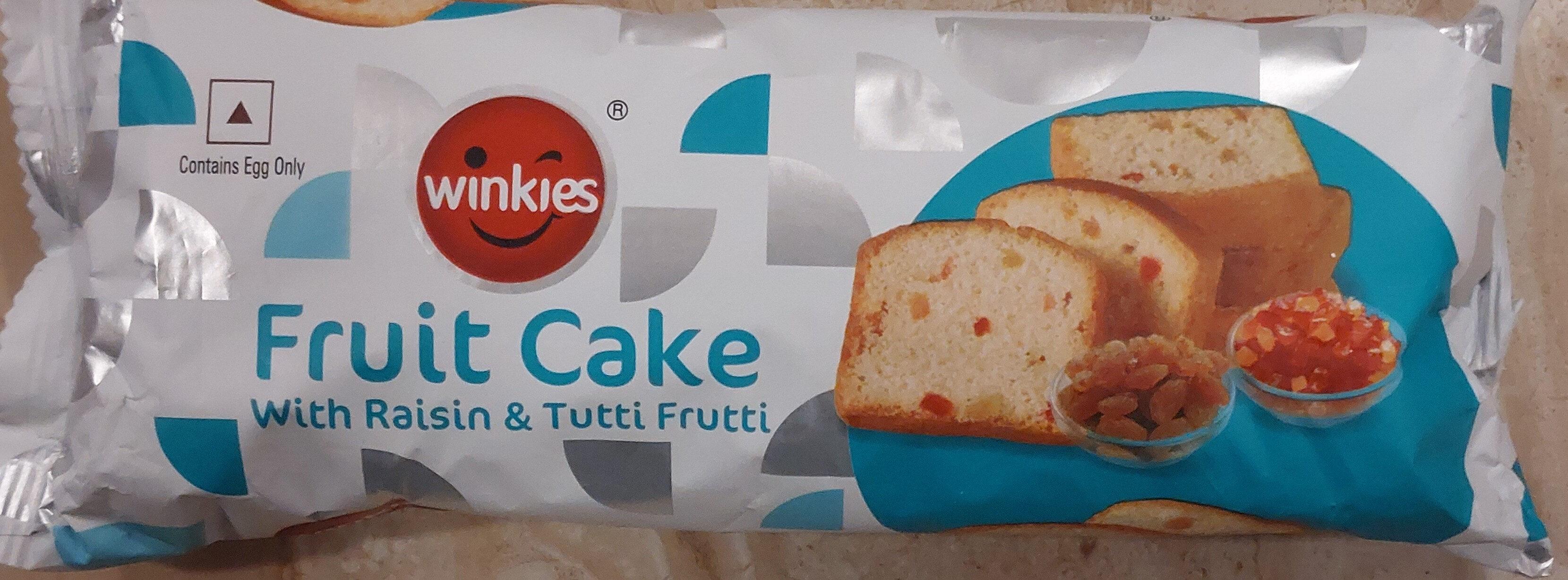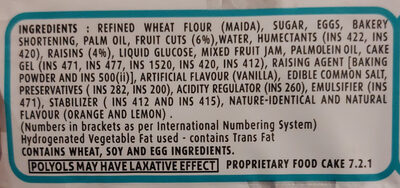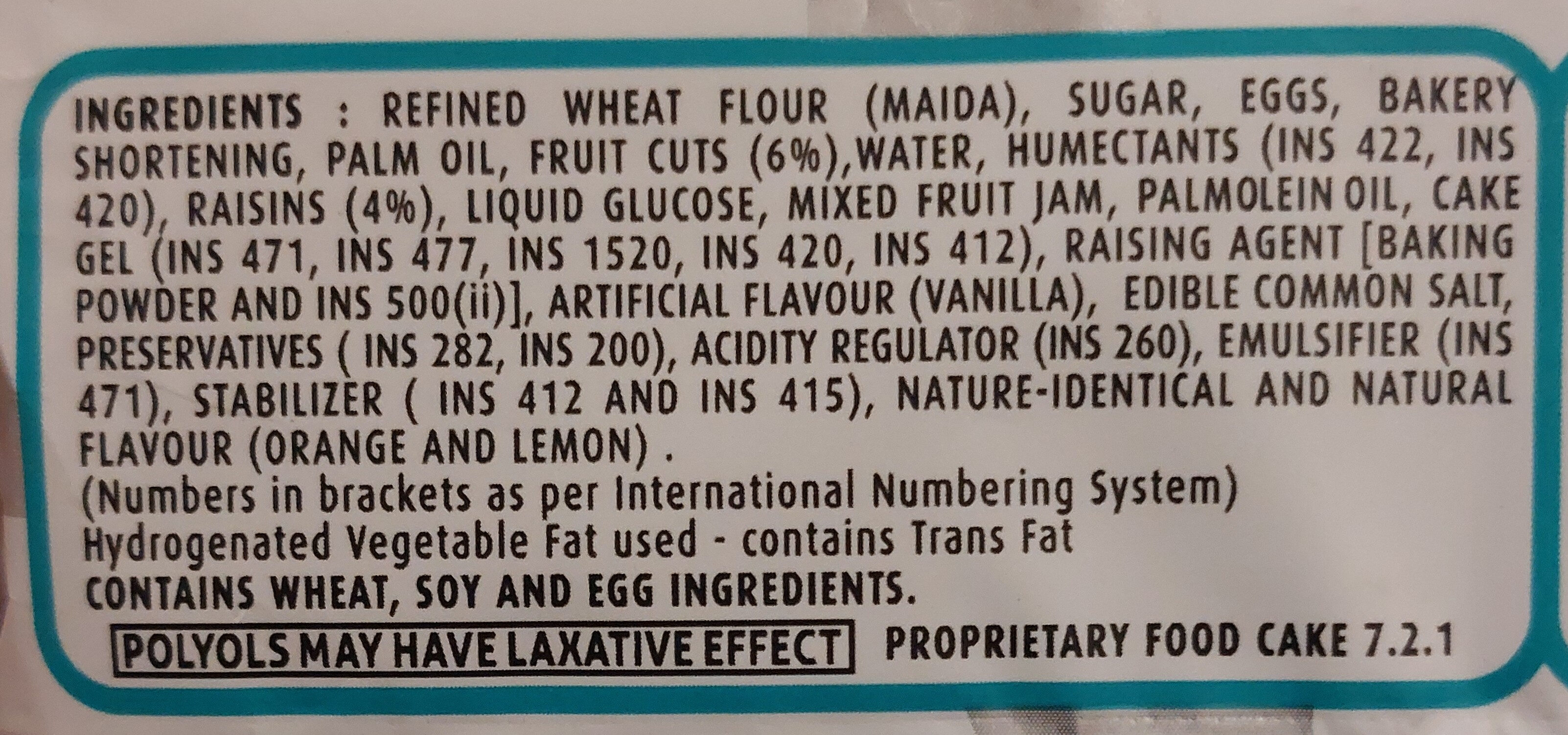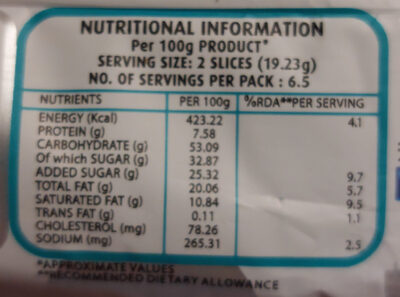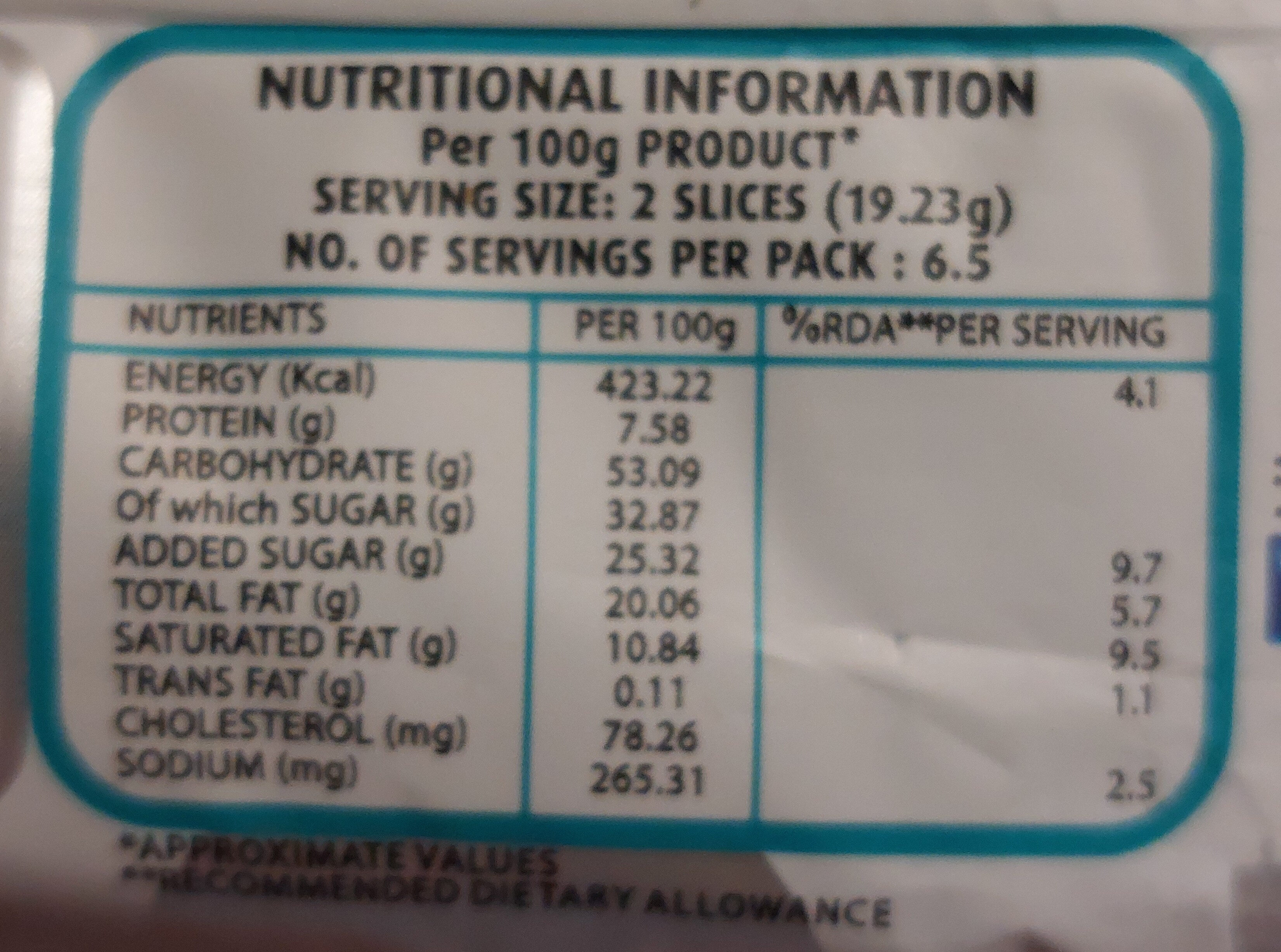Help us make food transparency the norm!
As a non-profit organization, we depend on your donations to continue informing consumers around the world about what they eat.
The food revolution starts with you!
Fruit Cake with Raisin & Tutti Frutti - winkies - 130 g
Fruit Cake with Raisin & Tutti Frutti - winkies - 130 g
This product page is not complete. You can help to complete it by editing it and adding more data from the photos we have, or by taking more photos using the app for Android or iPhone/iPad. Thank you!
×
Barcode: 8906005610591 (EAN / EAN-13)
Quantity: 130 g
Packaging: Plastic
Brands: Winkies
Categories: Snacks, Sweet snacks, Biscuits and cakes, Cakes, Fruit cakes
Labels, certifications, awards:
Non-vegetarian, Brown Triangle India
Countries where sold: India
Matching with your preferences
Health
Ingredients
-
43 ingredients
REFINED WHEAT FLOUR (MAIDA), SUGAR, EGGS, BAKERY SHORTENING, PALM OIL, FRUIT CUTS (6%), WATER, HUMECTANTS (INS 422, INS 420), RAISINS (4%), LIQUID GLUCOSE, MIXED FRUIT JAM, PALMOLEIN OIL, CAKE GEL (INS 471, INS 477, INS 1520, INS 420, INS 412), RAISING AGENT [BAKING POWDER AND INS 500(ii)], ARTIFICIAL FLAVOUR (VANILLA), EDIBLE COMMON SALT, PRESERVATIVES (INS 282, INS 200), ACIDITY REGULATOR (INS 260), EMULSIFIER (INS 471), STABILIZER ( INS 412 AND INS 415), NATURE-IDENTICAL AND NATURAL FLAVOUR (ORANGE AND LEMON). (Numbers in brackets as per International Numbering System) Hydrogenated Vegetable Fat used contains Trans Fat CONTAINS WHEAT, SOY AND EGG INGREDIENTS. POLYOLS MAY HAVE LAXATIVE EFFECT PROPRIETARY FOOD CAKE 7.2.1Allergens: Eggs, Gluten, Orange, SoybeansTraces: Eggs, Gluten, Soybeans
Food processing
-
Ultra processed foods
Elements that indicate the product is in the 4 - Ultra processed food and drink products group:
- Additive: E412 - Guar gum
- Additive: E415 - Xanthan gum
- Additive: E420 - Sorbitol
- Additive: E422 - Glycerol
- Additive: E471 - Mono- and diglycerides of fatty acids
- Additive: E477 - Propane-1‚2-diol esters of fatty acids
- Ingredient: Emulsifier
- Ingredient: Flavouring
- Ingredient: Glucose
- Ingredient: Humectant
Food products are classified into 4 groups according to their degree of processing:
- Unprocessed or minimally processed foods
- Processed culinary ingredients
- Processed foods
- Ultra processed foods
The determination of the group is based on the category of the product and on the ingredients it contains.
Additives
-
E200 - Sorbic acid
Sorbic acid: Sorbic acid, or 2‚4-hexadienoic acid, is a natural organic compound used as a food preservative. It has the chemical formula CH3-CH-4CO2H. It is a colourless solid that is slightly soluble in water and sublimes readily. It was first isolated from the unripe berries of the Sorbus aucuparia -rowan tree-, hence its name.Source: Wikipedia
-
E260 - Acetic acid
Acetic acid: Acetic acid , systematically named ethanoic acid , is a colorless liquid organic compound with the chemical formula CH3COOH -also written as CH3CO2H or C2H4O2-. When undiluted, it is sometimes called glacial acetic acid. Vinegar is no less than 4% acetic acid by volume, making acetic acid the main component of vinegar apart from water. Acetic acid has a distinctive sour taste and pungent smell. In addition to household vinegar, it is mainly produced as a precursor to polyvinyl acetate and cellulose acetate. It is classified as a weak acid since it only partially dissociates in solution, but concentrated acetic acid is corrosive and can attack the skin. Acetic acid is the second simplest carboxylic acid -after formic acid-. It consists of a methyl group attached to a carboxyl group. It is an important chemical reagent and industrial chemical, used primarily in the production of cellulose acetate for photographic film, polyvinyl acetate for wood glue, and synthetic fibres and fabrics. In households, diluted acetic acid is often used in descaling agents. In the food industry, acetic acid is controlled by the food additive code E260 as an acidity regulator and as a condiment. In biochemistry, the acetyl group, derived from acetic acid, is fundamental to all forms of life. When bound to coenzyme A, it is central to the metabolism of carbohydrates and fats. The global demand for acetic acid is about 6.5 million metric tons per year -Mt/a-, of which approximately 1.5 Mt/a is met by recycling; the remainder is manufactured from methanol. Vinegar is mostly dilute acetic acid, often produced by fermentation and subsequent oxidation of ethanol.Source: Wikipedia
-
E282 - Calcium propionate
Calcium propanoate: Calcium propanoate or calcium propionate has the formula Ca-C2H5COO-2. It is the calcium salt of propanoic acid.Source: Wikipedia
-
E412 - Guar gum
Guar gum (E412) is a natural food additive derived from guar beans.
This white, odorless powder is valued for its remarkable thickening and stabilizing properties, making it a common ingredient in various food products, including sauces, dressings, and ice creams.
When used in moderation, guar gum is considered safe for consumption, with no known adverse health effects.
-
E415 - Xanthan gum
Xanthan gum (E415) is a natural polysaccharide derived from fermented sugars, often used in the food industry as a thickening and stabilizing agent.
This versatile food additive enhances texture and prevents ingredient separation in a wide range of products, including salad dressings, sauces, and gluten-free baked goods.
It is considered safe for consumption even at high intake amounts.
-
E420 - Sorbitol
Sorbitol: Sorbitol --, less commonly known as glucitol --, is a sugar alcohol with a sweet taste which the human body metabolizes slowly. It can be obtained by reduction of glucose, which changes the aldehyde group to a hydroxyl group. Most sorbitol is made from corn syrup, but it is also found in nature, for example in apples, pears, peaches, and prunes. It is converted to fructose by sorbitol-6-phosphate 2-dehydrogenase. Sorbitol is an isomer of mannitol, another sugar alcohol; the two differ only in the orientation of the hydroxyl group on carbon 2. While similar, the two sugar alcohols have very different sources in nature, melting points, and uses.Source: Wikipedia
-
E422 - Glycerol
Glycerol: Glycerol -; also called glycerine or glycerin; see spelling differences- is a simple polyol compound. It is a colorless, odorless, viscous liquid that is sweet-tasting and non-toxic. The glycerol backbone is found in all lipids known as triglycerides. It is widely used in the food industry as a sweetener and humectant and in pharmaceutical formulations. Glycerol has three hydroxyl groups that are responsible for its solubility in water and its hygroscopic nature.Source: Wikipedia
-
E471 - Mono- and diglycerides of fatty acids
Mono- and diglycerides of fatty acids (E471), are food additives commonly used as emulsifiers in various processed foods.
These compounds consist of glycerol molecules linked to one or two fatty acid chains, which help stabilize and blend water and oil-based ingredients. E471 enhances the texture and shelf life of products like margarine, baked goods, and ice cream, ensuring a smooth and consistent texture.
It is generally considered safe for consumption within established regulatory limits.
-
E500 - Sodium carbonates
Sodium carbonates (E500) are compounds commonly used in food preparation as leavening agents, helping baked goods rise by releasing carbon dioxide when they interact with acids.
Often found in baking soda, they regulate the pH of food, preventing it from becoming too acidic or too alkaline. In the culinary world, sodium carbonates can also enhance the texture and structure of foods, such as noodles, by modifying the gluten network.
Generally recognized as safe, sodium carbonates are non-toxic when consumed in typical amounts found in food.
-
E500ii - Sodium hydrogen carbonate
Sodium hydrogen carbonate, also known as E500ii, is a food additive commonly used as a leavening agent.
When added to recipes, it releases carbon dioxide gas upon exposure to heat or acids, causing dough to rise and resulting in a light, fluffy texture in baked goods.
It is generally recognized as safe (GRAS) by regulatory authorities when used in appropriate quantities and poses no significant health risks when consumed in typical food applications.
Ingredients analysis
-
Palm oil
Ingredients that contain palm oil: Palm oil, Palm olein
-
Non-vegan
Non-vegan ingredients: EggSome ingredients could not be recognized.
We need your help!
You can help us recognize more ingredients and better analyze the list of ingredients for this product and others:
- Edit this product page to correct spelling mistakes in the ingredients list, and/or to remove ingredients in other languages and sentences that are not related to the ingredients.
- Add new entries, synonyms or translations to our multilingual lists of ingredients, ingredient processing methods, and labels.
If you would like to help, join the #ingredients channel on our Slack discussion space and/or learn about ingredients analysis on our wiki. Thank you!
-
Non-vegetarian
Some ingredients could not be recognized.
We need your help!
You can help us recognize more ingredients and better analyze the list of ingredients for this product and others:
- Edit this product page to correct spelling mistakes in the ingredients list, and/or to remove ingredients in other languages and sentences that are not related to the ingredients.
- Add new entries, synonyms or translations to our multilingual lists of ingredients, ingredient processing methods, and labels.
If you would like to help, join the #ingredients channel on our Slack discussion space and/or learn about ingredients analysis on our wiki. Thank you!
-
Details of the analysis of the ingredients
We need your help!
Some ingredients could not be recognized.
We need your help!
You can help us recognize more ingredients and better analyze the list of ingredients for this product and others:
- Edit this product page to correct spelling mistakes in the ingredients list, and/or to remove ingredients in other languages and sentences that are not related to the ingredients.
- Add new entries, synonyms or translations to our multilingual lists of ingredients, ingredient processing methods, and labels.
If you would like to help, join the #ingredients channel on our Slack discussion space and/or learn about ingredients analysis on our wiki. Thank you!
: REFINED WHEAT FLOUR (MAIDA), SUGAR, EGGS, BAKERY SHORTENING, PALM OIL, FRUIT CUTS 6%, WATER, HUMECTANTS (e422, e420), RAISINS 4%, GLUCOSE, MIXED FRUIT JAM, PALMOLEIN OIL, CAKE GEL (e471, e477, e1520, e420, e412), RAISING AGENT (BAKING POWDER, e500ii), ARTIFICIAL FLAVOUR (VANILLA), EDIBLE COMMON SALT, PRESERVATIVES (e282, e200), ACIDITY REGULATOR (e260), EMULSIFIER (e471), STABILIZER (e412, e415), NATURE-IDENTICAL and NATURAL FLAVOUR (ORANGE, LEMON, Numbers in brackets as per International Numbering System), INGREDIENTS, POLYOLS MAY HAVE LAXATIVE EFFECT PROPRIETARY FOOD CAKE 7.2.1- REFINED WHEAT FLOUR -> en:refined-wheat-flour - vegan: yes - vegetarian: yes - ciqual_proxy_food_code: 9410 - percent_min: 6 - percent_max: 58
- MAIDA -> en:refined-wheat-flour - vegan: yes - vegetarian: yes - ciqual_proxy_food_code: 9410 - percent_min: 6 - percent_max: 58
- SUGAR -> en:sugar - vegan: yes - vegetarian: yes - ciqual_proxy_food_code: 31016 - percent_min: 6 - percent_max: 32
- EGGS -> en:egg - vegan: no - vegetarian: yes - ciqual_food_code: 22000 - percent_min: 6 - percent_max: 23.3333333333333
- BAKERY SHORTENING -> en:bakery-shortening - percent_min: 6 - percent_max: 19
- PALM OIL -> en:palm-oil - vegan: yes - vegetarian: yes - from_palm_oil: yes - ciqual_food_code: 16129 - percent_min: 6 - percent_max: 16.4
- FRUIT CUTS -> en:fruit-cuts - percent_min: 6 - percent: 6 - percent_max: 6
- WATER -> en:water - vegan: yes - vegetarian: yes - ciqual_food_code: 18066 - percent_min: 4 - percent_max: 6
- HUMECTANTS -> en:humectant - percent_min: 4 - percent_max: 6
- e422 -> en:e422 - vegan: maybe - vegetarian: maybe - percent_min: 2 - percent_max: 6
- e420 -> en:e420 - vegan: yes - vegetarian: yes - percent_min: 0 - percent_max: 3
- RAISINS -> en:raisin - vegan: yes - vegetarian: yes - ciqual_food_code: 13046 - percent_min: 4 - percent: 4 - percent_max: 4
- GLUCOSE -> en:glucose - vegan: yes - vegetarian: yes - ciqual_proxy_food_code: 31016 - percent_min: 0 - percent_max: 4
- MIXED FRUIT JAM -> en:mixed-fruit-jam - percent_min: 0 - percent_max: 4
- PALMOLEIN OIL -> en:palm-olein - vegan: yes - vegetarian: yes - from_palm_oil: yes - ciqual_food_code: 16129 - percent_min: 0 - percent_max: 4
- CAKE GEL -> en:cake-gel - percent_min: 0 - percent_max: 4
- e471 -> en:e471 - vegan: maybe - vegetarian: maybe - from_palm_oil: maybe - percent_min: 0 - percent_max: 4
- e477 -> en:e477 - vegan: maybe - vegetarian: maybe - percent_min: 0 - percent_max: 2
- e1520 -> en:e490 - vegan: yes - vegetarian: yes - percent_min: 0 - percent_max: 1.33333333333333
- e420 -> en:e420 - vegan: yes - vegetarian: yes - percent_min: 0 - percent_max: 1
- e412 -> en:e412 - vegan: yes - vegetarian: yes - percent_min: 0 - percent_max: 0.8
- RAISING AGENT -> en:raising-agent - percent_min: 0 - percent_max: 4
- BAKING POWDER -> en:baking-powder - vegan: yes - vegetarian: yes - ciqual_food_code: 11046 - percent_min: 0 - percent_max: 4
- e500ii -> en:e500ii - vegan: yes - vegetarian: yes - percent_min: 0 - percent_max: 2
- ARTIFICIAL FLAVOUR -> en:artificial-flavouring - vegan: maybe - vegetarian: maybe - percent_min: 0 - percent_max: 4
- VANILLA -> en:vanilla - vegan: yes - vegetarian: yes - percent_min: 0 - percent_max: 4
- EDIBLE COMMON SALT -> en:salt - vegan: yes - vegetarian: yes - ciqual_food_code: 11058 - percent_min: 0 - percent_max: 0.67389
- PRESERVATIVES -> en:preservative - percent_min: 0 - percent_max: 0.67389
- e282 -> en:e282 - vegan: yes - vegetarian: yes - percent_min: 0 - percent_max: 0.67389
- e200 -> en:e200 - vegan: yes - vegetarian: yes - percent_min: 0 - percent_max: 0.336945
- ACIDITY REGULATOR -> en:acidity-regulator - percent_min: 0 - percent_max: 0.67389
- e260 -> en:e260 - vegan: yes - vegetarian: yes - percent_min: 0 - percent_max: 0.67389
- EMULSIFIER -> en:emulsifier - percent_min: 0 - percent_max: 0.67389
- e471 -> en:e471 - vegan: maybe - vegetarian: maybe - from_palm_oil: maybe - percent_min: 0 - percent_max: 0.67389
- STABILIZER -> en:stabiliser - percent_min: 0 - percent_max: 0.67389
- e412 -> en:e412 - vegan: yes - vegetarian: yes - percent_min: 0 - percent_max: 0.67389
- e415 -> en:e415 - vegan: yes - vegetarian: yes - percent_min: 0 - percent_max: 0.336945
- NATURE-IDENTICAL and NATURAL FLAVOUR -> en:nature-identical-and-natural-flavour - percent_min: 0 - percent_max: 0.67389
- ORANGE -> en:orange - vegan: yes - vegetarian: yes - ciqual_proxy_food_code: 13034 - percent_min: 0 - percent_max: 0.67389
- LEMON -> en:lemon - vegan: yes - vegetarian: yes - ciqual_proxy_food_code: 13009 - percent_min: 0 - percent_max: 0.336945
- Numbers in brackets as per International Numbering System -> en:numbers-in-brackets-as-per-international-numbering-system - percent_min: 0 - percent_max: 0.22463
- INGREDIENTS -> en:ingredients - percent_min: 0 - percent_max: 0.67389
- POLYOLS MAY HAVE LAXATIVE EFFECT PROPRIETARY FOOD CAKE 7.2.1 -> en:polyols-may-have-laxative-effect-proprietary-food-cake-7-2-1 - percent_min: 0 - percent_max: 0.67389
Nutrition
-
Bad nutritional quality
⚠ ️Warning: the amount of fiber is not specified, their possible positive contribution to the grade could not be taken into account.⚠ ️Warning: the amount of fruits, vegetables and nuts is not specified on the label, it was estimated from the list of ingredients: 4This product is not considered a beverage for the calculation of the Nutri-Score.
Positive points: 0
- Proteins: 4 / 5 (value: 7.58, rounded value: 7.58)
- Fiber: 0 / 5 (value: 0, rounded value: 0)
- Fruits, vegetables, nuts, and colza/walnut/olive oils: 0 / 5 (value: 4, rounded value: 4)
Negative points: 24
- Energy: 5 / 10 (value: 1771, rounded value: 1771)
- Sugars: 7 / 10 (value: 32.87, rounded value: 32.87)
- Saturated fat: 10 / 10 (value: 10.84, rounded value: 10.8)
- Sodium: 2 / 10 (value: 269.556, rounded value: 269.6)
The points for proteins are not counted because the negative points are greater or equal to 11.
Nutritional score: (24 - 0)
Nutri-Score:
-
Nutrient levels
-
Fat in high quantity (20.1%)
What you need to know- A high consumption of fat, especially saturated fats, can raise cholesterol, which increases the risk of heart diseases.
Recommendation: Limit the consumption of fat and saturated fat- Choose products with lower fat and saturated fat content.
-
Saturated fat in high quantity (10.8%)
What you need to know- A high consumption of fat, especially saturated fats, can raise cholesterol, which increases the risk of heart diseases.
Recommendation: Limit the consumption of fat and saturated fat- Choose products with lower fat and saturated fat content.
-
Sugars in high quantity (32.9%)
What you need to know- A high consumption of sugar can cause weight gain and tooth decay. It also augments the risk of type 2 diabetes and cardio-vascular diseases.
Recommendation: Limit the consumption of sugar and sugary drinks- Sugary drinks (such as sodas, fruit beverages, and fruit juices and nectars) should be limited as much as possible (no more than 1 glass a day).
- Choose products with lower sugar content and reduce the consumption of products with added sugars.
-
Salt in moderate quantity (0.674%)
What you need to know- A high consumption of salt (or sodium) can cause raised blood pressure, which can increase the risk of heart disease and stroke.
- Many people who have high blood pressure do not know it, as there are often no symptoms.
- Most people consume too much salt (on average 9 to 12 grams per day), around twice the recommended maximum level of intake.
Recommendation: Limit the consumption of salt and salted food- Reduce the quantity of salt used when cooking, and don't salt again at the table.
- Limit the consumption of salty snacks and choose products with lower salt content.
-
-
Nutrition facts
Nutrition facts As sold
for 100 g / 100 mlAs sold
per serving (19.23g)Compared to: Cakes Energy 1,771 kj
(423 kcal)341 kj
(81 kcal)+2% Fat 20.06 g 3.86 g +10% Saturated fat 10.84 g 2.08 g +24% Trans fat 0.11 g 0.021 g +39% Cholesterol 78,260 mg 15,000 mg +638% Carbohydrates 53.09 g 10.2 g -7% Sugars 32.87 g 6.32 g +5% Fiber ? ? Proteins 7.58 g 1.46 g +45% Salt 0.674 g 0.13 g +79% Fruits‚ vegetables‚ nuts and rapeseed‚ walnut and olive oils (estimate from ingredients list analysis) 4 % 4 %
Environment
-
Eco-Score C - Moderate environmental impact
⚠ ️The full impact of transportation to your country is currently unknown.The Eco-Score is an experimental score that summarizes the environmental impacts of food products.→ The Eco-Score was initially developped for France and it is being extended to other European countries. The Eco-Score formula is subject to change as it is regularly improved to make it more precise and better suited to each country.Life cycle analysis
-
Average impact of products of the same category: B (Score: 74/100)
Category: Fruit cake
Category: Fruit cake
- PEF environmental score: 0.32 (the lower the score, the lower the impact)
- including impact on climate change: 2.51 kg CO2 eq/kg of product
Stage Impact Agriculture
75.3 %Processing
12.2 %Packaging
7.4 %Transportation
3.5 %Distribution
1.5 %Consumption
0.0 %
Bonuses and maluses
-
Missing origins of ingredients information
Malus:
⚠ ️ The origins of the ingredients of this product are not indicated.
If they are indicated on the packaging, you can modify the product sheet and add them.
If you are the manufacturer of this product, you can send us the information with our free platform for producers.
-
Ingredients that threatens species
Malus: -10
Contains palm oil
Tropical forests in Asia, Africa and Latin America are destroyed to create and expand oil palm tree plantations. The deforestation contributes to climate change, and it endangers species such as the orangutan, the pigmy elephant and the Sumatran rhino.
-
Packaging with a medium impact
Malus: -10
Shape Material Recycling Impact Unknown Plastic High ⚠ ️ The information about the packaging of this product is not sufficiently precise (exact shapes and materials of all components of the packaging).⚠ ️ For a more precise calculation of the Eco-Score, you can modify the product page and add them.
If you are the manufacturer of this product, you can send us the information with our free platform for producers.
Eco-Score for this product
-
Impact for this product: C (Score: 49/100)
Product: Fruit Cake with Raisin & Tutti Frutti - winkies - 130 g
Life cycle analysis score: 74
Sum of bonuses and maluses: -20
Final score: 49/100
-
Carbon footprint
-
Equal to driving 1.3 km in a petrol car
251 g CO² per 100g of product
The carbon emission figure comes from ADEME's Agribalyse database, for the category: Fruit cake (Source: ADEME Agribalyse Database)
Stage Impact Agriculture
74.0 %Processing
8.5 %Packaging
11.2 %Transportation
5.5 %Distribution
0.8 %Consumption
0.0 %
Packaging
-
Packaging with a medium impact
-
Packaging parts
(Plastic)
-
Packaging materials
Material % Packaging weight Packaging weight per 100 g of product Plastic
-
Transportation
-
Origins of ingredients
Missing origins of ingredients information
⚠ ️ The origins of the ingredients of this product are not indicated.
If they are indicated on the packaging, you can modify the product sheet and add them.
If you are the manufacturer of this product, you can send us the information with our free platform for producers.Add the origins of ingredients for this product Add the origins of ingredients for this product
Threatened species
-
Contains palm oil
Drives deforestation and threatens species such as the orangutan
Tropical forests in Asia, Africa and Latin America are destroyed to create and expand oil palm tree plantations. The deforestation contributes to climate change, and it endangers species such as the orangutan, the pigmy elephant and the Sumatran rhino.
Report a problem
-
Incomplete or incorrect information?
Category, labels, ingredients, allergens, nutritional information, photos etc.
If the information does not match the information on the packaging, please complete or correct it. Open Food Facts is a collaborative database, and every contribution is useful for all.
Data sources
Product added on by chunkieramos
Last edit of product page on by chunkieramos.
Product page also edited by openfoodfacts-contributors.
